Looking back through my Electric guitar history, I’ve owned eight Stratocasters over the years. Why does it feel like coming home again this time around?
Hondo Stratocaster copy.
1990(ish). Candle Apple red. Rosewood fingerboard.
My first guitar, used with a fly-sec headphone amp. Looking back, it was decent enough to make me want to continue with the guitar, even though I had no idea at the time of the other options available. The first lick I learned, the live solo of Who Wants to Live Forever by Queen was on this guitar, and later on, it helped me through books 1-4 of Russ Shipton’s guide to Rock & Pop guitar. I was hooked and perhaps bonded to the Fender Stratocaster forever.
Fender Japanese Stratocaster.
Late 1980s. Candy Apple red. Maple fingerboard. System 1 Bridge/trem with locking nut.
My first proper guitar, or so I thought. I proudly barged into McKay’s Music in Newcastle with one aim; to come away with a guitar that was going to take my playing to the Stratosphere! (no pun intended).
I turned my nose up at a black USA Fender Stratocaster, which had a hard-tail and was £50 out of my price range, in the days of cash-only and no credit arrangements, and chose what I thought was some sort of speed machine, with the notoriously bad (although I didn’t know it at the time) System 1 Trem.
But I beared with. You couldn’t use the trem without it going out of tune. You couldn’t bend a string without a high chance of it breaking. String changes were a nightmare with that locking nut. But (apart from the trem) it was beautiful, it had a neck to die for, and all the classic Strat tones were present and correct. For all its faults, this was my first real encounter with a real Fender Stratocaster, and I was willing to forgive it for almost anything until I discovered I could save myself the pain with a Les Paul, fixed bridge type instrument.
My lasting memories of this instrument are it’s the one I got really good at the guitar with. I learned music theory on this, and the ability to play along to songs using scales, ultimately writing my own music. Proof that even a flawed instrument shouldn’t stop you. Most of all, I vividly remember the day I ran this through a maxed-out Squier 15-watt combo and experienced my first guitar playing itself moment I’ve rarely recaptured.
These particular Stratocasters are fairly sort-after these days. No idea why.
Fender Mexican Stratocaster.
1990’s. Black. Rosewood fingerboard.
It was a while before I gave Strats another chance, but in the midst of trying to find my voice with 335s, p90’s, etc, I reasoned I still hadn’t owned a solid, reliable Strat that functioned as it should, but the safe option of this one didn’t provide any zing whatsoever. A wholly vanilla experience from start to finish, sonically and under the fingers.
This particular Stratocaster accompanied me on the first rehearsal of a band I just couldn’t get into. Couldn’t get into the music. Couldn’t get into the guitar. Was this the end for me and Strats? Not yet, but once again, I switched back to the instant gratification of a Gibson Les Paul Standard.
Fender USA American Standard Stratocaster.
1997. Darkish Pearl blue. Rosewood fingerboard. Block saddles.
As the single-paced mud of the Les Paul grated on me, I once again foolishly entered Making Music in North Shields with a hot-head, zero homework, and the sales savvy of a charity worker. This was the first inkling I had that I should stop messing about with anything else and return home, to my first love. I saw this gleaming example up on the wall, a USA Standard no less, and talked myself out of about £500 in the process, as I handed over my almost new 1998 Ebony Gibson Les Paul Standard.
And it sounded amazing, better even than the Japanese one. It inspired me, I produced some more music and even got into gigging with it for a bit. This would have been a guitar for life, if only for the state of the frets.
Looking back, a fret-level would have sorted it, but I didn’t have the nouse, the experience, or the funds at the time. Guitars to me were, and still are, an emotional thing. I was disappointed, I had fallen out of love with it, and I knew I needed to move on to probably another horrendously unfair trade-in.
Yup. Back to Les Pauls, A Gordon Smith Graduate 60, followed by a Gibson Les Paul Studio, where I stayed for 10 years.
Squire Stratocaster.
2000’s. Sunburst. Tortoiseshell scratchplate. Rosewood fingerboard.
This one was a curiosity really, I was still cheating with the Studio, but in the back of my mind, I was always thinking of the liquid playing experience, the natural fit, and the bonding I had with the Strat.
I had the £80 asking price burning a hole in my pocket, so why not?
This was the cleanest guitar I’ve ever heard. Too clean, to the point that any sort of overdrive/distortion wasn’t an option. Should I have bothered coming back? Was the Strat ever any good?
Squire Japan Stratocaster
1990s. Olympic White. Maple fingerboard.
Then one day I saw this in Fretmarks Guitar in Bedlington, and I fell in love all over again, paying over £350 for a 30-year-old FugiGen Squier. In hindsight, these are the very guitars that Yamaha mocked so brutally(and successfully) as being plywood in their solid-bodied, Pacifica campaign of the 90s.
But I didn’t care. Just look at it.
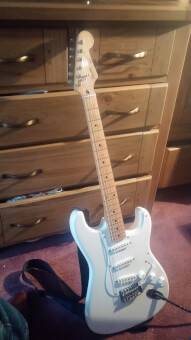
This guitar also introduced me to the delights of a 7.25″ radius fingerboard. It simply melted into my hand and brought it all back to me all over again. This is the one, isn’t it? I was almost done with anything with a 12″ radius (including Les Pauls). It feels like without the extra radius, my fingers are kind of stretching further across the board, which feels unnatural, uncomfortable, and weird.
But there were two big buts. Although I loved the 7.25″ most of the time. Big high bends and a low action were out, as they weren’t physically possible with this setup, and, I don’t know, despite the looks and the misty-eyed FujIGen nostalgia, this was a very cheap feeling and sounding budget instrument in all honesty.
But, crucially, although I’d now started to explore Telecasters for the first time, the Stratocaster flame had been lit once again.
Squier Affinity Stratocaster 20th Anniversary
2002. Dark Metallic Blue. Rosewood fingerboard.
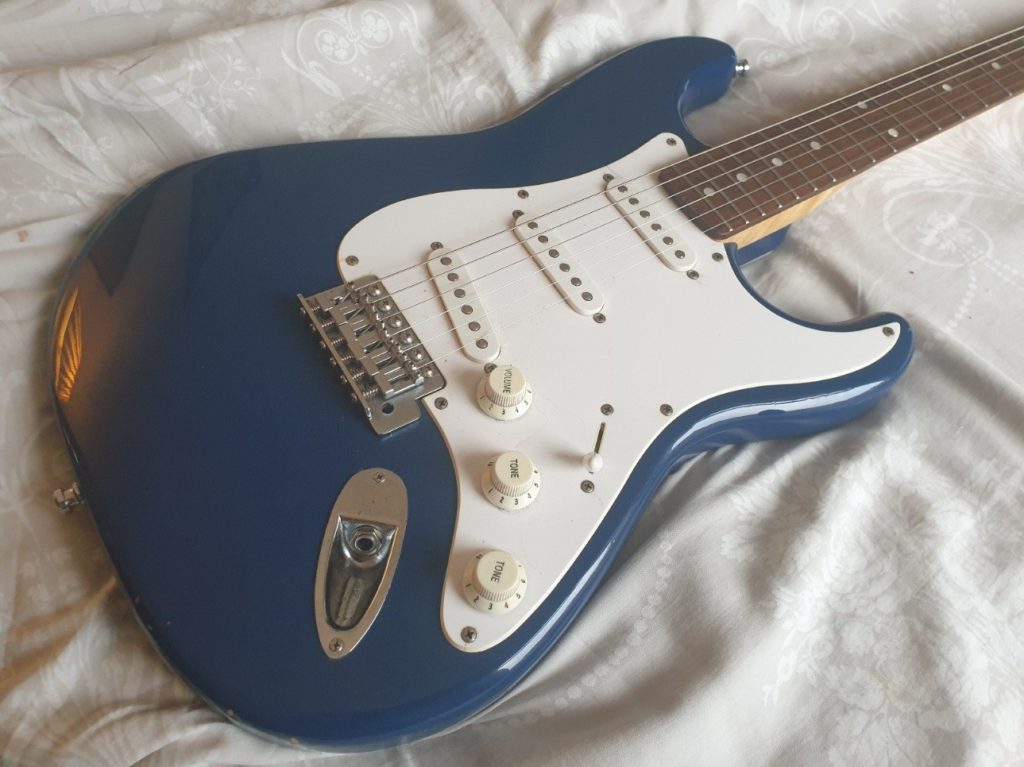
After a round of gigging with the ever-reliable Squier Telecaster Custom, into lockdown we all went, and something unexpected. A really kind gift from my Son’s auntie, which obviously I needed to examine…
It arrived in a bit of a state, needing a replacement tuner, a clean-up of the electrics, and a good bit of TLC and elbow grease, but this battered, unassuming little Squier made me fall in love with the Stratocaster all over again.
The thing was, once I’d fixed it up, cleaned it up, and set it up (including a bit of DIY fret filing), this guitar represented the only Strat I’ve owned in 32 years with not a single issue. Ok, the electrics are noisy but that’s what 30 years of abuse does to you.
I found myself noodling about, unamplified, on the sofa, in bed, for hours on end, just like in the beginning, simply enjoying the fretboard, the contours, and the acoustic tones, working on my playing. I could never do that on the heavy and cumbersome Les Paul.
It was almost time to come home again.
Fender Player Stratocaster
2021. Polar White. Pau Ferro Fingerboard. (Fender 75th Anniversary).
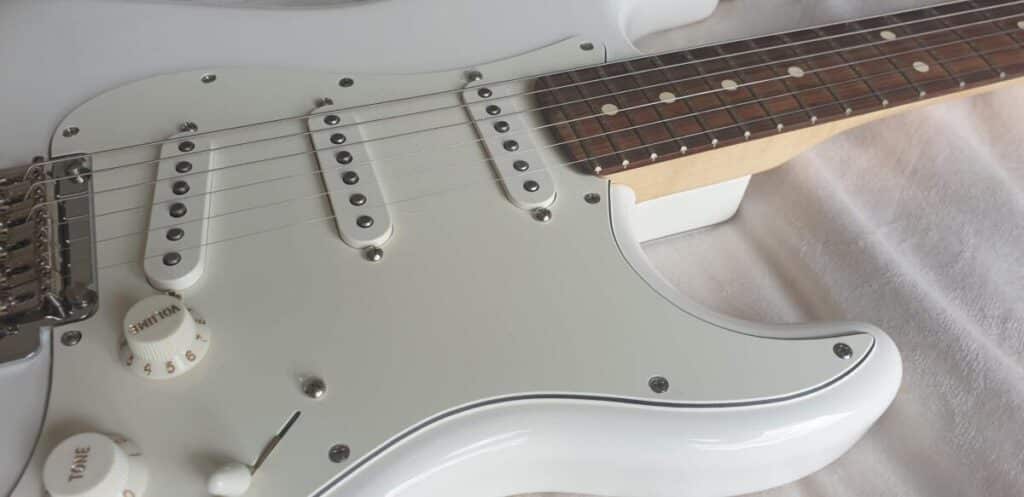
So here I am. I knew the next guitar purchase I made would be one to last me a while, perhaps till the end, and everything was pointing me in the direction of home, back to the Fender Stratocaster once again, right back to where it started.
I wanted to buy new to minimise the chance of fret issues etc, but also to choose the colour. It had to be Polar white and my preference of the warmer sounding, more luxurious feeling rosewood (now Pau Ferro) board.
It was every bit as perfect as I’d hoped. But from the start, I wanted to do things right. Do the measurements and set it up to standard Fender spec of 0.01″ relief and 4/64th action. I wanted a professional instrument adjusted to the official specs to last me a lifetime.
Now? No other guitar is getting a moment’s thought. It’s always been about the Fender Stratocaster, and finally, with this new Player, I’ve got my hands on one that both sounds and plays amazing.
It’s a big upgrade from the Squier, not least the quieter and better quality electrics, but every little thing is better. The tone, the playability, the quality. It’s devoid of all the issues I’ve been lumbered with over the years. The trem works beautifully, strings don’t snap when you bend them.
There are a few strats in this list that have been weak, limp, overly bright sounding, or simply boring. This isn’t.
And finally, the 9.5″ inch radius fingerboard is the best compromise. No choking on bends but not too flat either.
But it’s not about measurements and specs. Most importantly, I’ve been on a journey since I was 16 to find my voice so to speak on the guitar. The Stratocaster has frustrated me at times but even though I’ve owned a few it’s only really been the last two that have confirmed what I guess I always knew.
The Fender Stratocaster will always be my home.
(Full review of the Fender Player Stratocaster coming soon).

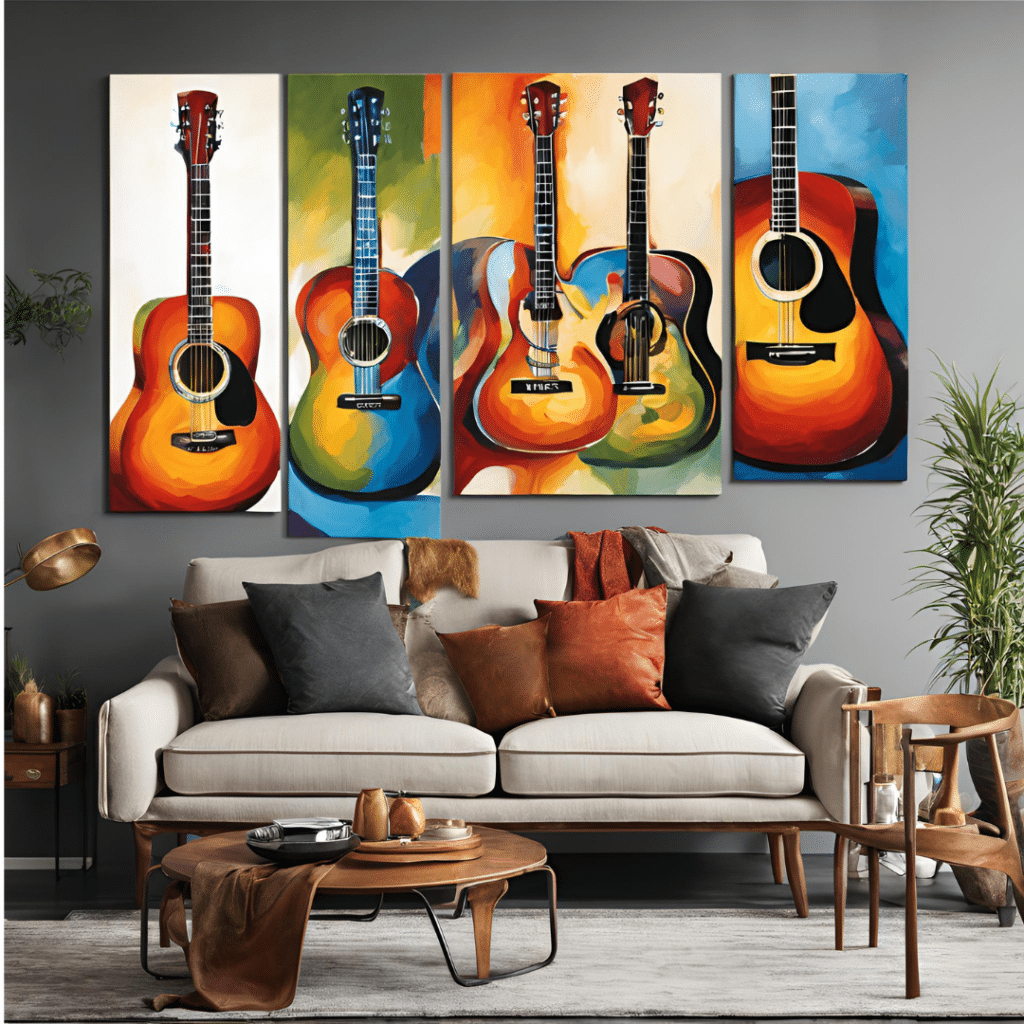
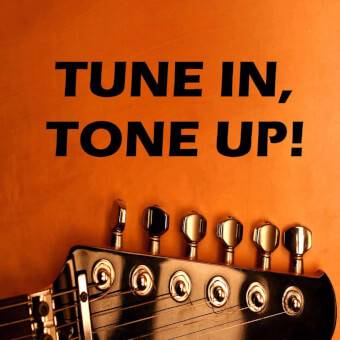
Hey man, this post randomly came up in my Google News Feed – I didn’t have a chance to read through the whole post just yet (I’m at work), but I scrolled to the bottom to see which guitar you landed on that felt like coming home – and sure enough, it’s the same Stratocaster my aunt gifted me when my band was starting to take off and do well (I was playing on an aged-white, Squire, Bullet Strat that I had to tune between each song I played prior to receiving her gift). Really awesome you feel that way. It my go-to guitar and I don’t know if I’ll ever need anything else.
I started playing guitar somewhere around 13-15 years old, and I’m turning 27 this year. I played in a little Pop-Punk band that frequently covered Blink-182 songs in middle-school through early highschool and at the time I played a cherry-red, Epiphone Les Paul. It was a good guitar, but it always felt like it was missing something when I played it. And I was so poor that my only pedal was a boss ds-1 and I played through a crappy secondhand amp I got at a pawn shop (don’t even remember the name).
For years, as I got better at guitar, I couldn’t figure out why – even though I was playing the instrument correctly – I couldn’t get it to sound the way I wanted it to. I felt like I was doing something wrong, and anytime my band would jam I felt like something was missing from my playing. My band eventually broke up and I left to play acoustic guitar for years (where I honed a lot of my playing style and skills, and learned to favor open and complex chords). This was until I found a Strat in a pawn shop.
I always hated Fender as a kid. I have a bit of a tendency to hate things that are trendy, and universally praised or loved – I don’t know why. Maybe it’s that little punk-rock kid that likes to fight the current still within me. I saw Strats everywhere growing up and I thought it was so lame how everyone seemed to choose the same guitar. I wanted something different and unique, and always thought Fenders were the guitars boring, vanilla, milquetoast players chose. I wanted something with character – something more unique with more personality.
Not only this, but I had played a handful of Stratocaster-like guitars from different brands growing up, and I hated all of them. There was a Yamaha Strat-knockoff that was named “Janet” by my band and our music-oriented friend group, that made its way from person to person, as they inevitably got sick of playing the trash and passed it along to someone else. This helped burn my hatred of strats even deeper.
So, when I entered a Pawn-Shop at the age of… 17? I saw a used, Squire Bullet Strat hanging on the wall and picked it up as a joke, laughing, expecting to hold a hunk of junk in my hands. I expected to hold some flimsy, garbage guitar with sharp frets, bad intonation and horrible string action.
But when I picked it up… my life literally changed.
It felt like nothing I had ever played in my entire life before. The strings were responsive. The action was amazing. The guitar was light, but felt sturdy. The cutout in the back was comfortable. The frets were cleanly filed. This guitar felt like anything BUT cheap.
I was in love. This guitar HAD to be mine. I needed to buy it THAT DAY. There wasn’t a fiber in my entire body or soul that doubted this – and I didn’t even plug the damn thing into an amp to play it! I strummed on it without an amp! For all I knew, the wiring could have been cut into pieces on the inside and it wouldn’t make sound if I plugged it into anything – but I didn’t even care. It felt so right in my hands, I had to buy it.
I brought the guitar up to the desk to speak to the guy working the register. At this time, I didn’t have a credit card or a debit card. I paid for things only in cash – and I had no cash on me. I asked the man if I could hold this guitar here, behind the front desk, and come back tomorrow after stopping at my bank to buy the guitar (it was a Sunday and my bank was closed – and I didn’t know how to pull cash from an ATM without a card).
The guy told me he could, but only with a 30% down-payment. The beauty in my hands was $100, so I needed to give him $30. I was with my buddy at the time, who drove us there – and he didn’t have any cash on him either, so we were stuck.
I remembered they closed at 6pm, and at that time it was 5pm – one hour to close. I was SO convinced that if I didn’t buy it or put it on hold THAT DAY, someone else would find it the next day and buy it immediately. I didn’t want anyone else to grab it off the wall and have the same revelation I did – so I asked the front desk-guy for a favor. I asked if he could just hold it behind the desk for an hour – until they close – and I’d be back with a down-payment. He agreed, and I asked the friend who drove me to bring me back to my place. I had an idea.
My piggy bank back at home was not very full – but it was the only spot I had any money (excluding the bank, of course, which was closed). We raced home, I broke that sucker out, and counted the coins I had. I just BARELY had $30 and only about 5 to 10 of it was in quarters – the rest were nickels, dimes, and pennies. I tossed everything into a zip-loc bag, and hopped back into the car.
We rushed back to the pawn shop and arrived with about 30 minutes left before store close. I ran in, plopped my coins onto the counter, and the cashier literally looked at me and said, “are you kidding me, man?” I laughed and shrugged, as he rolled his eyes and counted up $30 in change – and remember, only a small portion was in quarters, so there were a lot of coins this man had to count right before store-close.
With that, the guitar was successfully held, and I stopped in the next day after running to my bank to grab cash, and the guitar was officially mine. I remember riding in the back seat of my buddy’s car with the strat, just eyeing it up and feeling the magic and potential emanating from it. I had recently been gifted a friend’s Fender-branded, small, 10″-cone, solid-state, simulator amp just a week or two prior, and promptly plugged it in when I got home. The amp rattled pretty badly when you brought the volume up – so I wasn’t able to play it loud, but I didn’t care. The sound that came out of that guitar and through that speaker was something I had never heard before. My playing on an electric guitar felt right for the first time in my whole life. The sound was so crisp, so pure, so clean. I had no idea single coils could sound like this, and I finally understood what people meant when they said humbuckers clean tones are “muddy”, because this was the clearest tone I had ever heard.
My whole life changed. This guitar was my everything and I would eventually move to the cities in my state and pursue my dream of being a musician. I had started a new band, we played college house shows and gained a little following. We released two EPs and an Album, and we’re currently working on a new EP and a new follow-up album.
My aunt – who loves music – saw me play a few times at a bars and always noticed how often I had to retune my guitar due to the cheap tuners, and eventually gifted me a Polar White, Pau Ferro Neckboard, Fender brand, Player Series Stratocaster – the same one as the last spot in your post. It’s been my go-to guitar ever since, and feels like the upgraded, top-of-the-line version of my Bullet Strat that I fell in love with. I still have my Squire, love it dearly, and bring it to shows as my backup in case a string snaps during a show – but the player series Strat is everything I’ve ever wanted in a guitar. I’ve had multiple times where I had the itch to buy another guitar, and realized I don’t know what other kind of guitar I would want – because if I got another one, I would just get this guitar again. It’s my baby – my dream guitar, and when I play, it feels like home to me.
I gotta get back to work, but thanks for giving me the opportunity to get nostalgic. Thanks dude, keep playing – have a good one!
Hey Adam.
Thanks for this and good to know I’m not the only one to have so many Strat-related dramas!
I wanted one so bad once that I did a straight swap, an older USA Standard Strat (90’s probably) for my almost new Gibson Les Paul Standard, (1998 year I think). Terrible, terrible naive deal, and a complete rip-off…….. but I just wanted that Strat so bad and when I got it, I didn’t care…. until I couldn’t cope with the worn frets anymore..
On the other hand, I had one of those awful 80’s Japanese Strats, the one with the System One trem. Wonderful neck but just didn’t stay in tune and strings would break on almost every full-tone bend! Those are worth a lot of money now but I remember swapping the lot (including the case and pedals) for an Epiphone LP100. Unbelievable now but at the time I just remember the desperation of either needing a Strat or wanting rid of one.
Fast forward to today and yeah, the Player Strat, once it had some attention to the frets, nut and I’d got rid of those horrible bent steel saddles, is pretty much the perfect electric guitar. I couldn’t help but get curious about the Epiphone Inspired by Gibson Les Paul Junior though…
One thing the strat does not have is that plug-and-play, immediate ‘grunt’ that the junior has. It’s the antithesis of the Strat in every way, and I’m loving owning both ends of the spectrum, but after playing anything, including the Junior, the Strat just seems so easy and sleek to play, it still feels like home.
And if ever I get that itch.. I pick up Junior.
Sorry for the Strat waffle.